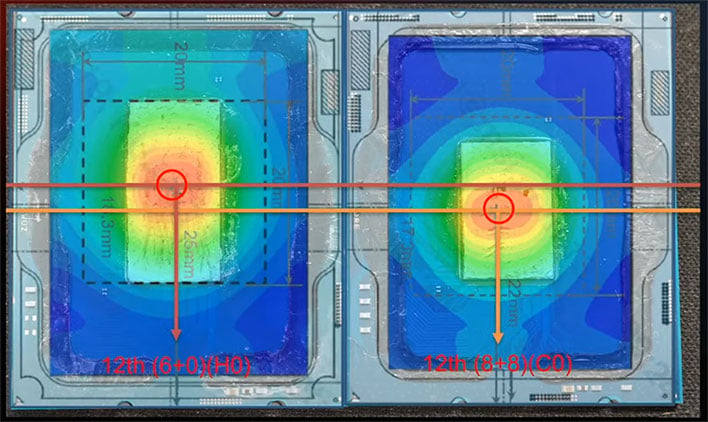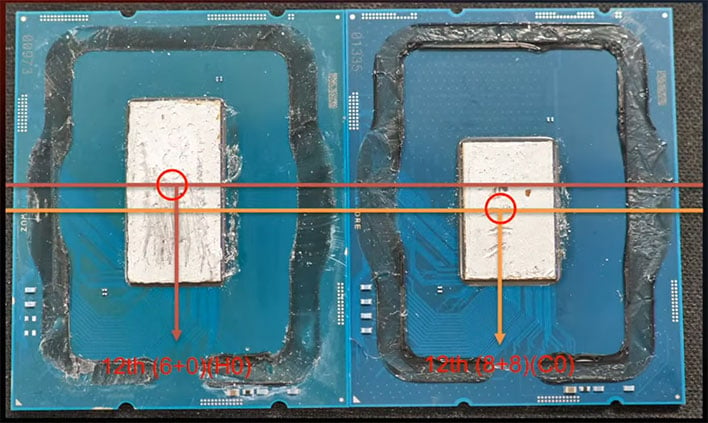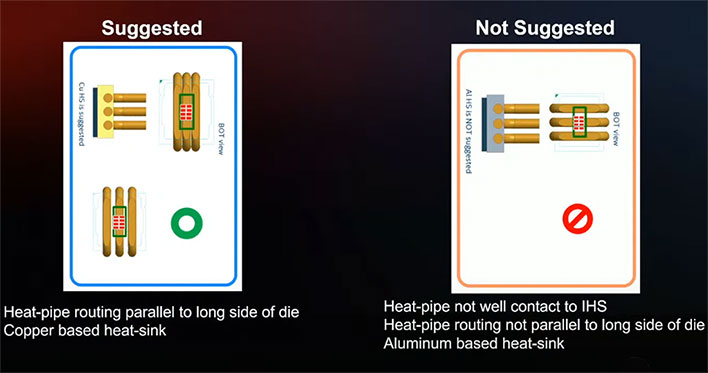MSI Says Alder Lake’s Hotspots Need Specific Cooling Configs To Maximize Performance
According to MSI, it will be more important than ever to select the right cooler for Intel's new Alder Lake CPUs, and to make sure it is being mounted correctly. The reason? In short, the hotspots on different Alder Lake CPUs could be located in slightly different areas due to the hybrid makeup of the chip, and whether you select one with both Golden Cove and Gracemont cores, or just Golden Cove cores underneath the hood.
A high-level overview can be seen in the thermal image above, which MSI shared during its latest MSI Insider episode on YouTube. Note that they are labeled incorrectly—the chip on the left is actually an Alder Lake CPU with an 8+8 configuration (as would be the case for a Core i9-12900K, for example), while the one on the right sports a 6+0 configuration, meaning it only has high-performance cores on board.
The die sizes are different, and so are the areas that generate the most amount of heat. As such, making proper contact with your CPU cooler is imperative.
This is something that was touched upon last week when a picture emerged purporting to show what kind of contact different coolers make when applied to an Alder Lake CPU. While not confirmed, the photo was probably supplied by MSI, as it showed the thermal paste on the underside of its K360 all-in-one liquid cooler being the most evenly spread, versus supposedly sloppy contact on coolers from Corsair and Cooler Master.
Starting at the 48-minute mark in the MSI Insider video, hosts Eric van Beurden and Michiel Berkhout discuss the altered Z-height of Alder Lake, the new hole pattern to accommodate the LGA 1700 socket on Z690 motherboards, hotspots on different types of Alder Lake CPUs, and more.
"It is very important to have the right cooling," Eric notes while pointing out the differing hotspots. Michiel follows that up by saying, "Also it means that the pressure points are quite important because you don't want have for example one part of the CPU properly covered by the other one not. If it doesn't touch the heat-spot properly, then of course your temperatures will rise."
Also interesting is that the hosts really emphasize using liquid cooling with Alder Lake rather than an air cooler, especially for higher-end SKUs. Eric eventually backs down a bit and acknowledges that an air cooler will work, but they both suggest not only going with an AIO liquid cooler, but the bigger the better.
Part of the reason, according to them, is that the direct-contact heatpipes on a typical air cooler are spread out a little bit, and may not make great contact with the part of the CPU die that heats up the most. The big takeaway seems to be that you'll want to do a bit more research than usual when picking out a cooler for Alder Lake.
This is something we'll be sure to keep an eye on as times go on, and when test Alder Lake for ourselves.




